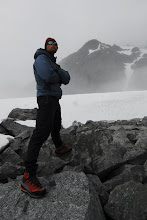














Does it get any better?? Pitch 6 (AI3)
I slipped into my rock shoes and raced as fast as possible up the summit tower. Six pitches of pleasant jamming later and an easy ridge traverse planted us on the summit block, the shrieking wind helpless against our enthusiasm. My first Patagonian summit felt extra sweet since it was a moment I had waited for since 2008, the same year I came to Chalten only to watch one of Patagonia's best weather windows ever slip by as I battled pneumonia.

To the top!
I've realized in my time here that the descents off these towers defines the difficulty of the experience as much as the steep ice and technical rock that guards each summit. I have done routes of similar difficulty and size elsewhere, but walking off the top pales in comparison with travel back down the route, all the while battling relentless winds that throw your ropes straight out from the wall.

To the bottom!
Our descent was challenging, but we finally made it down to the glacier. Unfortunately, our two half ropes suffered greatly, one core shot and part of the other buried under a ton of snow and ice after a piece of the bergshrund collapsed under Colin's feet. "It ain't over until it's over," was a statement that echoed in my head during the isothermic snow slog from hell back to our base camp.
"Jardines Japoneses" is fondly named after one of the best rock pitches in the world (in our very biased opinions!) found at the Lower Town Walls at Index. Washington represent!
